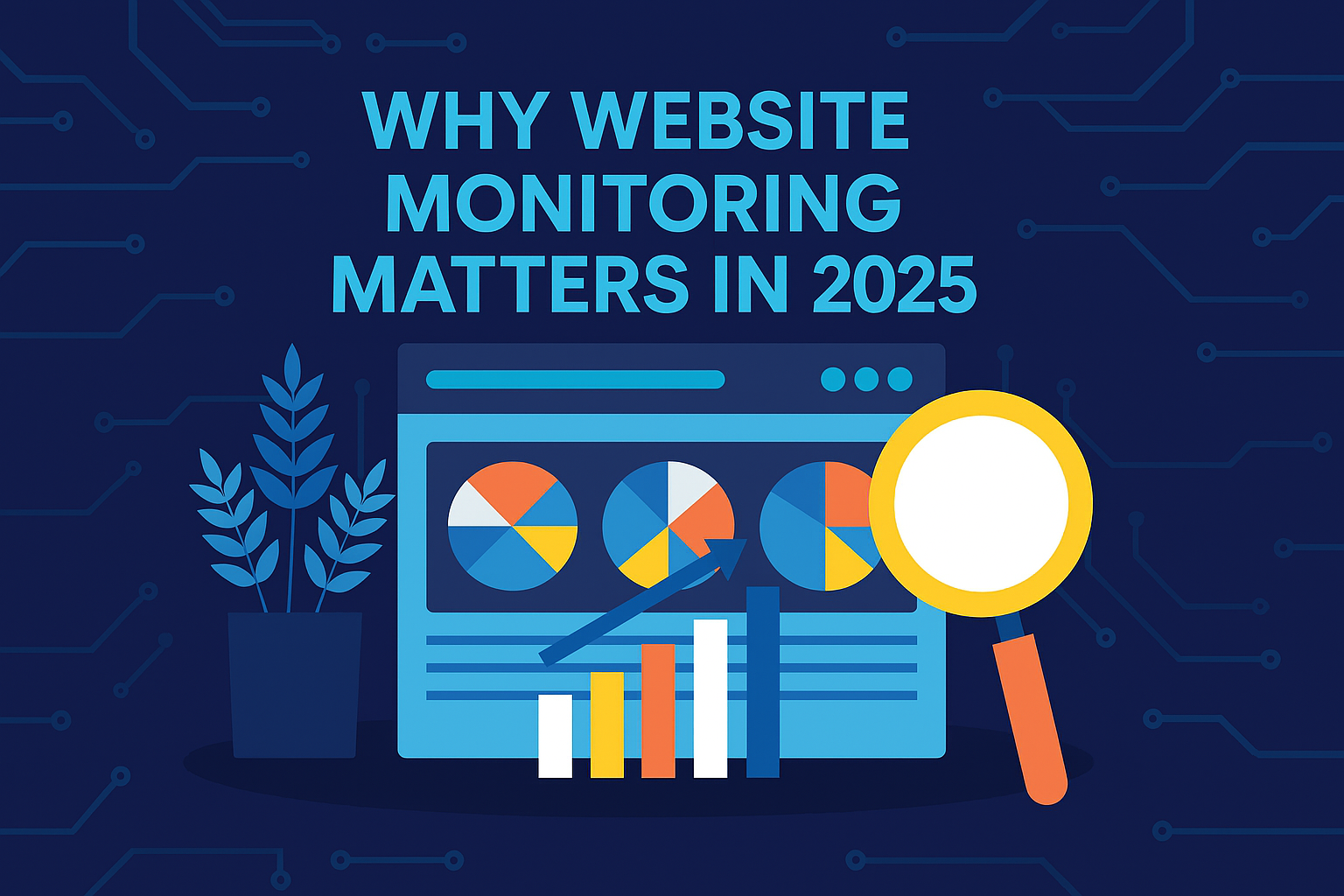
Why Website Monitoring Matters in 2025
In today's digital-first world, website downtime can cost businesses thousands of dollars per minute. With users expecting 99.9%+ uptime and sub-second response times, comprehensive website monitoring has become essential for any online business.
Website monitoring goes far beyond simple uptime checks. Modern monitoring solutions provide insights into performance, user experience, security, and business impact. In this comprehensive guide, we'll explore everything you need to know about website monitoring in 2025.
Types of Website Monitoring
1. Uptime Monitoring
Uptime monitoring is the foundation of any monitoring strategy. It checks if your website is accessible and responding to requests from various locations around the world.
- HTTP/HTTPS Monitoring: Checks if your website responds with proper HTTP status codes
- DNS Monitoring: Ensures your domain resolves correctly
- SSL Certificate Monitoring: Tracks certificate expiration and validity
- Global Monitoring: Tests from multiple geographic locations
2. Performance Monitoring
Performance monitoring focuses on how fast your website loads and responds to user requests.
- Response Time Monitoring: Measures how long your server takes to respond
- Page Load Time Monitoring: Tracks complete page load times
- Resource Monitoring: Monitors individual assets (CSS, JS, images)
- Database Performance: Tracks query response times
3. User Experience Monitoring
Real User Monitoring (RUM) provides insights into how actual users experience your website.
- Core Web Vitals: Monitors LCP, FID, and CLS metrics
- User Journey Monitoring: Tracks user interactions and flows
- Error Tracking: Captures JavaScript errors and exceptions
- Conversion Impact: Correlates performance with business metrics
Essential Monitoring Metrics
Availability Metrics
- Uptime Percentage: The percentage of time your website is accessible
- Mean Time Between Failures (MTBF): Average time between outages
- Mean Time to Recovery (MTTR): Average time to restore service
- Response Time: How quickly your server responds to requests
Performance Metrics
- Page Load Time: Total time to load a complete page
- Time to First Byte (TTFB): Time until the first byte is received
- Core Web Vitals: Google's key performance indicators
- Throughput: Number of requests handled per second
Setting Up Your Monitoring Strategy
Step 1: Define Your Monitoring Goals
Before implementing any monitoring solution, clearly define what you want to achieve:
- What constitutes downtime for your business?
- What performance thresholds are acceptable?
- Who needs to be notified when issues occur?
- What actions should be taken during incidents?
Step 2: Choose Your Monitoring Locations
Select monitoring locations based on your user base and business requirements:
- Primary Markets: Monitor from locations where most of your users are located
- Global Coverage: Ensure monitoring from multiple continents
- CDN Testing: Monitor from locations where your CDN has edge servers
- Mobile Networks: Include mobile network testing for mobile users
Step 3: Configure Alerting
Set up intelligent alerting to ensure you're notified of issues without alert fatigue:
- Escalation Policies: Define who gets notified and when
- Alert Deduplication: Prevent multiple alerts for the same issue
- Custom Thresholds: Set different thresholds for different times of day
- Multiple Channels: Use email, SMS, Slack, and other notification methods
Advanced Monitoring Features
Transaction Monitoring
Monitor critical user journeys and business processes:
- E-commerce checkout flows
- User registration and login processes
- Payment processing workflows
- API endpoint chains
Synthetic Monitoring
Simulate user interactions to proactively detect issues:
- Automated form submissions
- Multi-step user journeys
- API testing with authentication
- Database query monitoring
Infrastructure Monitoring
Monitor the underlying infrastructure that supports your website:
- Server resource utilization (CPU, memory, disk)
- Database performance and connections
- Network latency and bandwidth
- Third-party service dependencies
Best Practices for 2025
1. Monitor from Multiple Locations
Use monitoring locations that match your user base to get accurate performance data.
2. Set Realistic Thresholds
Base your alerting thresholds on actual user experience data, not arbitrary numbers.
3. Implement Progressive Monitoring
Start with basic uptime monitoring and gradually add more sophisticated features.
4. Focus on Business Impact
Monitor metrics that directly impact your business goals and user satisfaction.
5. Automate Incident Response
Use automated workflows to handle common issues and reduce manual intervention.
6. Regular Review and Optimization
Continuously review your monitoring strategy and adjust based on changing needs.
Choosing the Right Monitoring Tool
When selecting a website monitoring solution, consider these factors:
- Ease of Setup: How quickly can you get started?
- Monitoring Locations: Does it cover your target markets?
- Alerting Options: Can it notify your team through preferred channels?
- Integration Capabilities: Does it work with your existing tools?
- Scalability: Can it grow with your business?
- Cost: Is it within your budget for the features you need?
Conclusion
Website monitoring is no longer optional in 2025. With users expecting flawless experiences and businesses depending on online presence, comprehensive monitoring is essential for success.
By implementing the strategies outlined in this guide, you'll be well-equipped to detect and resolve issues before they impact your users and business. Remember, the goal isn't just to monitor—it's to create a better experience for your users and protect your business from costly downtime.
Ready to get started with comprehensive website monitoring? Try KeepWatch free for 14 days and see how easy it is to implement professional-grade monitoring for your website.